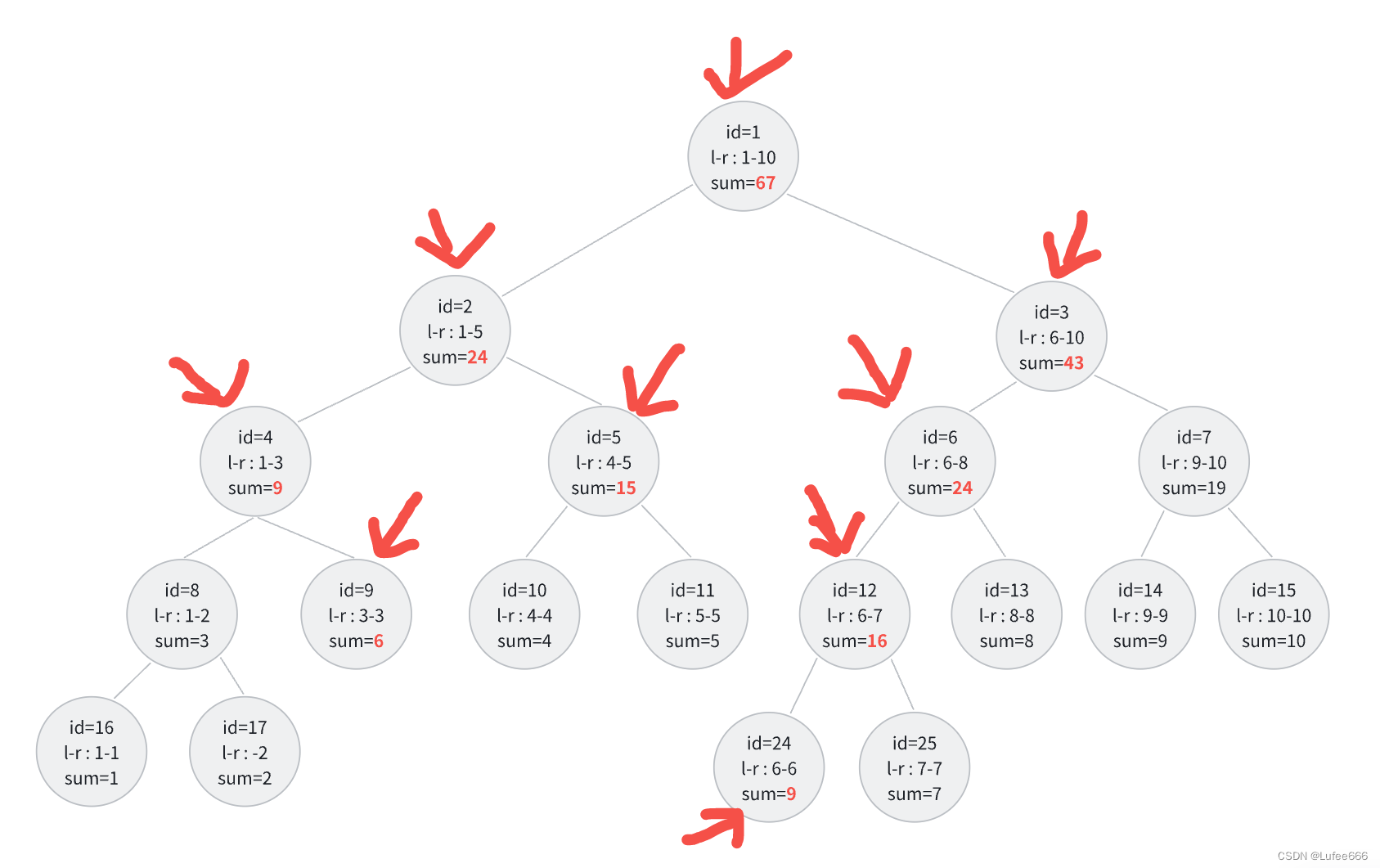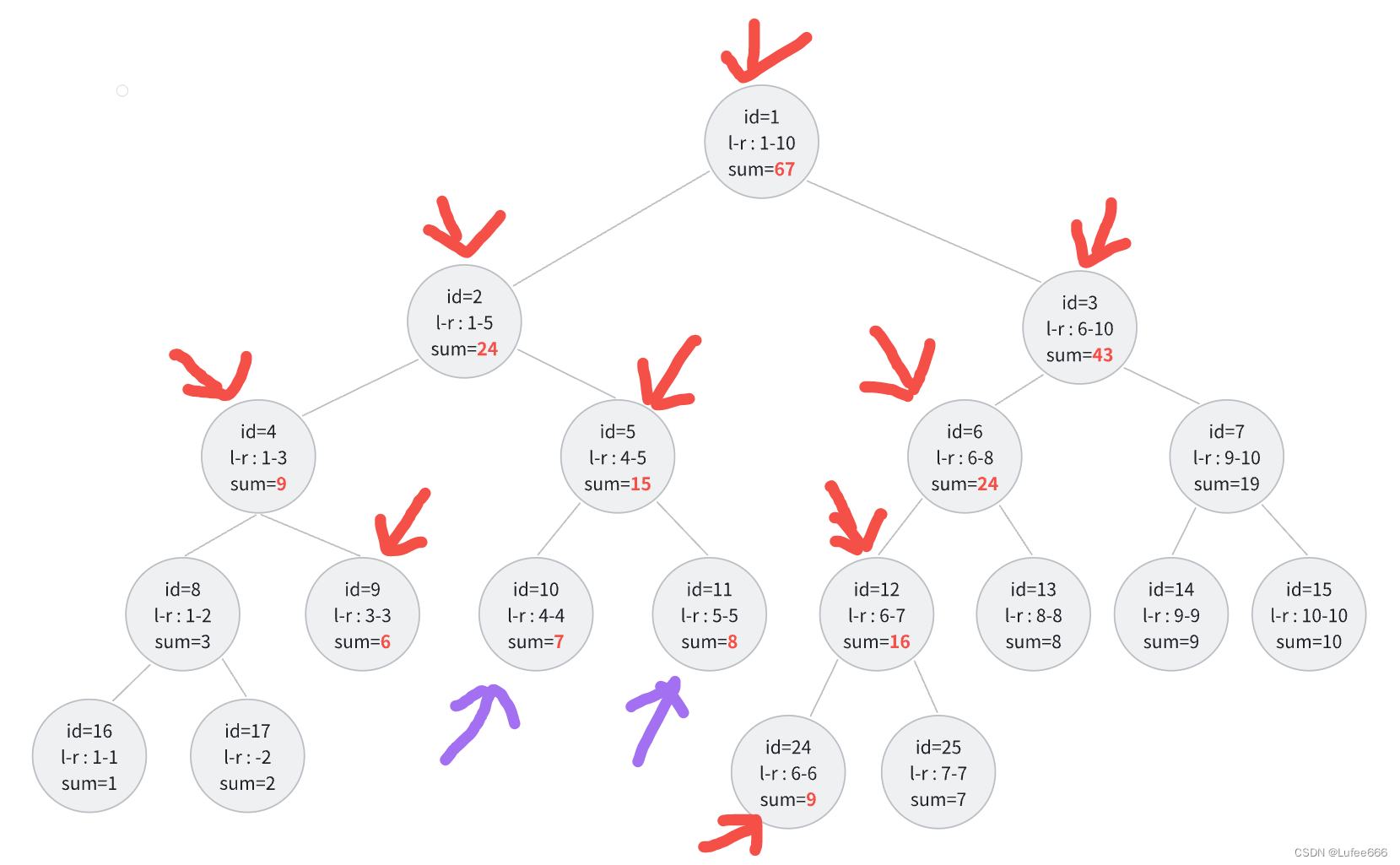目录
描述
You have N integers, A1, A2, ... , AN. You need to deal with two kinds of operations. One type of operation is to add some given number to each number in a given interval. The other is to ask for the sum of numbers in a given interval.
输入
The first line contains two numbers N and Q. 1 ≤ N,Q ≤ 100000.
The second line contains N numbers, the initial values of A1, A2, ... , AN. -1000000000 ≤ Ai ≤ 1000000000.
Each of the next Q lines represents an operation.
"C a b c" means adding c to each of Aa, Aa+1, ... , Ab. -10000 ≤ c ≤ 10000.
"Q a b" means querying the sum of Aa, Aa+1, ... , Ab.
输出
You need to answer all Q commands in order. One answer in a line.
样例输入
10 5
C 3 6 3
Q 2 4
样例输出
9
15思路
不要看这题全英文,但这题就是属于线段树模版题,基本做法是一样的
建树

第一次错误解法(正确解法在下面,可跳过这一步)
树没有更新成功,id=10,id=11理论上是要继续更新他们的sum值,但我的错误代码没有更新

#define _CRT_SECURE_NO_WARNINGS 1
#include<iostream>
using namespace std;
const int N = 100010;
#define ll long long
ll nums[N];
struct Tree {
int l, r;
ll sum;
ll tag;
}tree[N << 2];
void pushup(int u) {
tree[u].sum = tree[u << 1].sum + tree[u << 1 | 1].sum;
}
void build(int l, int r, int u) {
if (l == r) tree[u] = { l,r,nums[l] };//要与结构体Tree一一对应
else {
tree[u] = { l,r };
int mid = (l + r) >> 1;
build(l, mid, u << 1);
build(mid + 1, r, u << 1 | 1);
pushup(u);
}
}
ll query(int L, int R, int u) {
int l = tree[u].l, r = tree[u].r;
if (l >= L && r <= R)return tree[u].sum;
int mid = (l + r) >> 1;
ll sum = 0;
if (L <= mid) sum += query(L, R, u << 1);
if (R > mid) sum += query(L, R, u << 1 | 1);
return sum;
}
void pushdown(int u, int ln, int rn) {
if (tree[u].tag) {
tree[u << 1].tag += tree[u].tag;
tree[u << 1 | 1].tag += tree[u].tag;
tree[u << 1].sum += tree[u].tag * ln;
tree[u << 1 | 1].sum += tree[u].tag * rn;
tree[u].tag = 0;
}
}
void updatespan(int L, int R, int value, int u) {
int l = tree[u].l, r = tree[u].r;
int mid = (l + r) >> 1;
if (l >= L && r <= R) {
tree[u].tag += value;
tree[u].sum += value * (r - l + 1);
return;
}
pushdown(u, mid - l + 1, r - mid);
if (L <= mid) updatespan(L, R, value, u << 1);
if (R > mid) updatespan(L, R, value, u << 1 | 1);
pushup(u);
}
int main()
{
int n, q;
while (scanf("%d%d", &n, &q) != EOF) {
for (int i = 1; i <= n; i++) scanf("%lld", &nums[i]);
build(1, n, 1);
while (q--) {
string cz;
int op1, op2;
cin >> cz;
if (cz == "C") {
int val;
scanf("%d%d%d", &op1, &op2, &val);
updatespan(op1, op2, val, 1);
}
else {
scanf("%d%d", &op1, &op2);
printf("%lld\n", query(op1, op2, 1));
}
}
}
return 0;
}正确解法
关键在于updatespan函数中,if语句中我没有继续pushdown导致错误

code
#define _CRT_SECURE_NO_WARNINGS 1
#include<iostream>
using namespace std;
const int N = 100010;
#define ll long long
ll nums[N];
struct Tree {
int l, r;
ll sum;
ll tag;
}tree[N << 2];
void pushup(int u) {
tree[u].sum = tree[u << 1].sum + tree[u << 1 | 1].sum;
}
void build(int l, int r, int u) {
if (l == r) {
tree[u] = { l,r,nums[l] };//要与结构体Tree一一对应
else {
tree[u] = { l,r };
int mid = (l + r) >> 1;
build(l, mid, u << 1);
build(mid + 1, r, u << 1 | 1);
pushup(u);
}
}
ll query(int L, int R, int u) {
int l = tree[u].l, r = tree[u].r;
if (l >= L && r <= R)return tree[u].sum;
int mid = (l + r) >> 1;
ll sum = 0;
if (L <= mid) sum += query(L, R, u << 1);
if (R > mid) sum += query(L, R, u << 1 | 1);
return sum;
}
void pushdown(int u, int ln, int rn) {
if (tree[u].tag) {
tree[u << 1].tag += tree[u].tag;
tree[u << 1 | 1].tag += tree[u].tag;
tree[u << 1].sum += tree[u].tag * ln;
tree[u << 1 | 1].sum += tree[u].tag * rn;
tree[u].tag = 0;
}
}
void updatespan(int L, int R, int value, int u) {
int l = tree[u].l, r = tree[u].r;
int mid = (l + r) >> 1;
if (l >= L && r <= R) {
tree[u].tag += value;
tree[u].sum += value * (r - l + 1);
pushdown(u, mid - l + 1, r - mid);//关键
return;
}
pushdown(u, mid - l + 1, r - mid);
if (L <= mid) updatespan(L, R, value, u << 1);
if (R > mid) updatespan(L, R, value, u << 1 | 1);
pushup(u);
}
int main()
{
int n, q;
while (scanf("%d%d", &n, &q) != EOF) {
for (int i = 1; i <= n; i++) scanf("%lld", &nums[i]);
build(1, n, 1);
while (q--) {
string cz;
int op1, op2;
cin >> cz;
if (cz == "C") {
int val;
scanf("%d%d%d", &op1, &op2, &val);
updatespan(op1, op2, val, 1);
}
else {
scanf("%d%d", &op1, &op2);
printf("%lld\n", query(op1, op2, 1));
}
}
}
return 0;
}



















 170
170











 被折叠的 条评论
为什么被折叠?
被折叠的 条评论
为什么被折叠?








